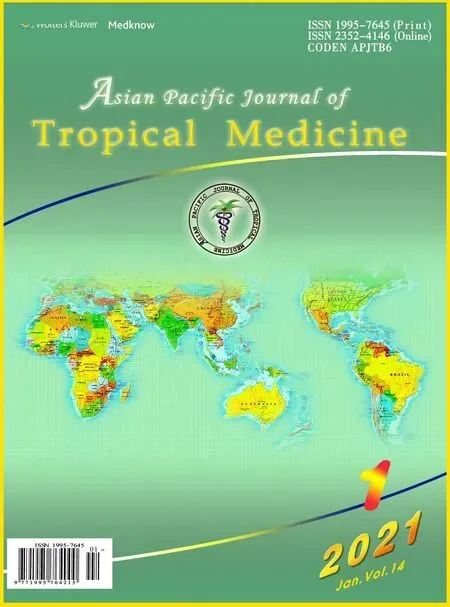Association between Guillain-Barré syndrome and hepatitis E infection:A datadriven ecological study in Hong Kong
Xue Liang, Shi Zhao
1Department of Hematology, The 989th Hospital of the Joint Logistics Support Force of Chinese PLA, Luoyang, 471031, China
2JC School of Public Health and Primary Care, Chinese University of Hong Kong, Hong Kong SAR, China
3Shenzhen Research Institute of Chinese University of Hong Kong, Shenzhen, China
Guillain-Barré syndrome (GBS) is an uncommon neurological disorder that may cause damage to the peripheral nerves[1].The triggering of GBS is commonly caused by Campylobacter jejuni and other bacterial and viral infections.Hepatitis infections as the triggering factors including hepatitis A, B, C, E viruses are being increasingly recognized[2,3].Among all hepatitis, hepatitis E virus(HEV) is more likely to be under-diagnosed, most being subclinical infections.In developed countries, extra-hepatic manifestations as well as clinical disorders may occur[2].
In Hong Kong, there are 0.79 GBS per 100 000 population every year from 2004 to 2018 with an annual growth of 1.91%.Although recently, many studies have suggested an association between GBS and some flavivirus, e.g., Zika virus, dengue virus[4,5], and Chikungunya virus.The number of the local infections of these viruses is at extremely low levels, some with an annual number of zero cases[6].For hepatitis, there are 3.30 hepatitis cases per 100 000 population every year of the same period including 1.13 HEV cases[6].To the best of our knowledge, only one case report on GBS associated with HEV was published in the preceding 20 years[7].
As an exploration, we investigated the statistical associations between GBS and hepatotropic viruses in Hong Kong from 2004 to 2018.The monthly number of GBS and different types of hepatitis time series was freely obtained via the Centre for Health Protection(CHP) of Hong Kong[6].Linear fixed effect regression was employed to model the number of GBS as a response to different types of hepatitis in Eqn (1).

Here, the function E[∙]is the expectation.The termτis the time lag, and we consider +1 month lag in GBS to account for the development of syndromes[8].The function I(∙) is an indication function, and it returns 1 for ‘true’values, and 0 otherwise.The time period, denoted by t, before or after 2010 was considered as a dummy variable accounting for unexplainable variation before and after influenza pandemic.As such, the regression coefficient,β, can be transferred to ‘percentage change of GBS when one unit increases in hepatitis’, namely, [(e-1)×100%]is the percentage change.
We found a positive association between GBS and HEV that can be interpreted as an estimated 2.01% (95% CI:0.41%-3.62%)increase in the number of GBS about to occur if there is an increase of one more HEV case.This estimation became 2.61% (95% CI:1.01%-4.24%) when only data after 2010 was used (Figure 1).This association did not reach significance in 2004 to 2009, and all other hepatotropic viruses were not significantly associated with GBS, either.The under-diagnosis of HEV infection may cause extra occurrences of manifestations of the disorder[2], which includes GBS as one of the commonly noticed complications.Our findings suggest that extra caution may be needed for the situation that HEV is complicated by GBS.

Figure 1.The scatter plot and the fitted regression models of the monthly number of HEV cases and GBS cases (with +1 month lag) in Hong Kong from 2004 to 2018.The triangular dots represent the observed data, and the curves are the fitted regression models, where shading areas represent 95% confidence interval(CI).Downward triangles (blue) are the number of cases reported between 2004 and 2009, and upward triangles (red) are the number of cases reported between 2010 and 2018.The blue/red curve is the fitted regression model using data before/after 2010.The dark green curve is the fitted regression model using data from 2004 to 2018.The dashed curve (blue) indicates that the regression coefficient is not statistically significant.
Conflict of interest statement
The authors declare that there are no conflicts of interests.
Authors’contributions
All authors designed the study, collected the data, conducted the analysis, drafted and critically revised the manuscript, and approved for publishing.
 Asian Pacific Journal of Tropical Medicine2021年1期
Asian Pacific Journal of Tropical Medicine2021年1期
- Asian Pacific Journal of Tropical Medicine的其它文章
- Gender disparity in COVID-19:Role of sex steroid hormones
- Total spinal involvement due to delayed diagnosis and treatment of noncontiguous brucellar spondylitis
- Gracilaria changii (Rhodophyta) alleviates bisphenol A-induced adverse reproductive abnormalities in mice
- Anopheles gambiae larvicidal and adulticidal potential of Phyllanthus amarus(Schumach and Thonn, 1827) obtained from different localities of Nigeria
- Intestinal parasitic infections and risk factors among Myanmar migrant workers in northeast Thailand
- Seroprevalence of SARS-CoV-2 in Mazandaran province, Iran
